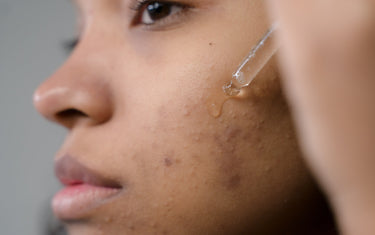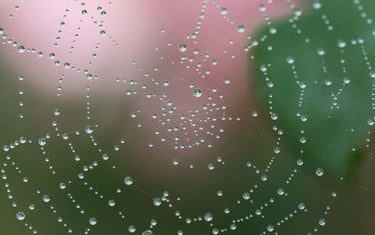11 min read / 5 January 2023 / yasmin sharp
How to Use Tea Tree Oil for Acne
This popular essential oil also doubles as an effective skin treatment. Learn how to use it here.
Share this post

How do you use tea tree oil for acne?
What's the connection between tea tree oil and acne?
Is tea tree oil good for spots?
How else can tea tree oil benefit the skin?
Unless you're very lucky, chances are you've had at least one stubborn pimple in your life.
For the majority of us, the figure is much higher than that - and for those with acne-prone skin, spot woes may feel like an overwhelming and unwelcome part of life.
Battling the annoying side effects of acne can be incredibly troublesome, especially if you have no idea on where to start with getting rid of them.
Even for those with the odd spot now and then, trying to diminish the problem can seem like an endless mystery without antidote.
How to Use Tea Tree Oil for AcneThe most important thing to remember with any essential oil is they're extremely potent. Applying copious amounts of tea tree oil to your skin, especially when undiluted, can not only irritate your skin greatly and make matters much, much worse, but also create an insufferable dryness that could lead to painful cracks and peeling. Here’s a helpful guide for safe and effective application:
|
What's the connection between tea tree oil and acne?
Despite a number of potions, creams, and bizarre home remedies out there (insert the visual of smearing toothpaste all over your face here), many of us still can't find the exact key formula for melting away our acne without worrisome side effects that could end up causing more trouble than they're worth.
This is where tea tree essential oil comes into play - the secret ingredient to a whole world of clearer, healthier skin.
At first glance, tea tree oil may seem like nothing more than another pointless fad, but what are the true facts behind using tea tree oil for acne?
We'll be exploring what exactly makes this all-natural remedy such a staple for our skin, as well as how to use tea tree oil for acne in your day-to-day routine.

What is tea tree essential oil?
Tea tree oil, also known by the botanical name Melaleuca Alternifolia, is derived from the leaves of the native Australian shrub and was once used by indigenous people for a great number of physical ailments.
In fact, its growing list of benefits has become so renowned in the modern world of aromatherapy that many have affectionately nicknamed it the "medicine cabinet in a bottle".
With a strong, distinctively herbaceous scent and a clear colouring, tea tree oil has developed uses for everything from fighting infections and relieving congestion to boosting hair health.
Is tea tree oil good for spots?
Tea tree oil is packed full of nourishing benefits for our skin - ones that become particularly useful when applied to acne bumps and spots.
This is largely due to the oil's anti-inflammatory and antibacterial properties, which a study in 2017 [1] found could effectively cleanse and clear the skin after daily use over a twelve week period.
Those in the study with mild to moderate acne also reported a significant reduction within this time period.
Effective natural ingredients
While there are a wide number of essential oils out there with antimicrobial effects, many scientists believe tea tree is so effective because of its main active ingredient, terpinene-4-ol.
This naturally-occurring compound is said to destabilise the cells within bacteria, killing them from within and allowing the body to heal over time. A study in 2012 [2] even noted this effect as useful for those suffering with psoriasis.
Paired with the anti-inflammatory effects that help reduce redness and puffiness, acne breakouts appear virtually invisible with just a bit of tea tree oil at your disposal.
Combating the small and large breakouts
And the benefits of tea tree oil for acne don't end there, either. Unlike some other remedies, tea tree can accommodate for both comedonal breakouts (whiteheads, blackheads, etc.) and inflammatory breakouts (the big, red zits). It can also reduce their severity and frequency over time.
So, does tea tree oil help with acne? In short, absolutely. In fact, the effects of this oil have become so notable that they're often compared [3] to the popular acne treatment benzoyl peroxide.
While they may be a bit slower to get started, the effects are ultimately better off, as tea tree is the more naturally moisturising of the two options for the skin.

What to look for in tea tree oil
When you're shopping for tea tree oil, here are a few key things to keep an eye out for:
- Purity: Look for 100% pure tea tree oil. This means it hasn't been diluted with other oils or additives, which can reduce its effectiveness.
- Packaging: Tea tree oil should be in a dark, glass bottle. This helps protect it from light, which can degrade the oil over time.
- Latin Name: Check the label for the Latin name 'Melaleuca alternifolia'. This confirms you're getting the real deal and not a different type of tea tree oil.
- Organic Certification: If you can, go for organic. This means the oil is free from pesticides and other chemicals.
- Sourcing Information: Good brands often provide details about where their tea tree oil is sourced from. Australian tea tree oil is often considered high quality.
How else can tea tree oil benefit the skin?
Aside from its acne-busting abilities, tea tree has other powerful properties that can help improve our skin health overall.
Tea tree oil can be used as an effective after sun treatment for sunburn, as well as a useful remedy for inflamed or itchy insect bites.
It is also renowned for its abilities against dandruff, helping to heal the scalp and reduce dryness with regular use.
All of these benefits are thanks to the strong anti-inflammatory effects of the oil, as well as its antimicrobial properties which are said to help clear the skin of any unwelcome infections, abrasions, or sores.

What are some other ways you can use tea tree oil?
Aside from its amazing benefits for your skin, tea tree oil is incredibly versatile and has a range of other uses. Here are 5 common uses:
1. All-Purpose Cleaner
Tea tree oil's natural antibacterial properties make it an excellent addition to homemade cleaning solutions. Mix a few drops of tea tree oil with water, vinegar, and a bit of lemon juice for a natural, effective cleaner.
This mixture can be used on kitchen surfaces, bathroom tiles, and other areas in your home. It's a great way to avoid harsh chemicals while still keeping your home clean and fresh-smelling.
2. Treat Nail Fungus
Tea tree oil is often used to treat nail fungus due to its natural antifungal and antiseptic properties.
Studies indicate that tea tree essential oil can effectively eliminate fungus either when combined with other treatments or used alone, and it also tends to cause fewer side effects. [4]
However, it's important to note that while tea tree oil can help with fungal infections, its effectiveness can vary depending on the severity of the infection and the individual.
Take a look at our blog on tea tree oil for nail fungus for more information.
3. Hair Growth
Some people find that tea tree oil can promote hair growth. It helps to unclog hair follicles and nourish the roots.
To use it for hair growth, you can mix a few drops of tea tree oil with a carrier oil like coconut oil, massage it into your scalp, leave it on for a few minutes, and then wash it out. Learn more about tea tree oil for hair over on our blog.
4. Insect Repellent
Tea tree oil can be a natural alternative to chemical-based insect repellents. Its strong smell is unappealing to many types of insects.
One study discovered that it outperformed DEET – the primary active ingredient in most commercial insect repellents – in repelling mosquitoes. [5]
You can mix it with water and spray it around your home, or apply a diluted mixture on your skin.
It's especially effective against mosquitoes, ants, and other common pests.
5. Natural Antiseptic for Cleaning Wounds
While this is slightly related to skin, it's more about first aid. Tea tree oil can be used to clean cuts and abrasions.
A study conducted on 10 individuals with wounds, found that except for one participant, everyone experienced quicker healing times, leading to faster wound recovery. [6]
For this purpose, dilute tea tree oil in a carrier oil or water and apply it to the wound with a clean cotton bud.
However, it's important to use it cautiously and always diluted, as it can be too harsh if applied directly in its pure form.

Are there any possible side effects of using tea tree oil for spots?
However you choose to implement tea tree oil into your routine, the indisputable step is to always perform a patch test before using it on your skin.
While tea tree oil works like a charm on most skin types, those with very sensitive skin may develop itching, swelling, or redness with contact.
In cases like this, you should always cease use immediately to avoid making matters worse.
Tea tree oil is also more likely to trigger allergic reactions in some, so this step is even more important if you're prone to allergies.
What other essential oils are good for acne?
Tea tree oil may be best in show when it comes to eliminating acne woes, but it is certainly not the only essential oil with skin-clearing advantages under its belt.
If you're not a big fan of the strong smell of tea tree, or you find the formula doesn't quite agree with your skin, some other great options include:
Geranium is a particularly great choice for more sensitive skin types, as it is a naturally gentle oil with similar anti-inflammatory properties.
If you're in need of some more recommendations, our guide to the best essential oils for treating acne can help.
Frequently Asked Questions
How often should I use tea tree oil for my acne?
Once you've done a patch test to ensure the oil is safe for your skin, try to apply it at least once a day for the best results.
This should be done in conjunction with any other acne treatments you may have in your regimen.
How should I apply tea tree oil to my skin?
Dampen the end of a cotton bud and gently circle it around the lid of your tea tree oil bottle. This will pick up a sufficient amount of product to apply safely to the skin.
You can also use a cotton ball or the damp end of a face cloth if you prefer.
How long does it take for tea tree oil to clear acne?
The time it takes for tea tree oil to clear acne can vary depending on the individual's skin type, the severity of the acne, and how the skin reacts to the oil.
Generally, some people may start to see improvements in their acne within a few weeks of consistent use.
However, it's important to remember that skincare results can vary greatly from person to person, and patience is key.
Consistent, daily application is typically necessary to see noticeable results.
Can I leave tea tree oil on my face overnight?
Yes, you can leave tea tree oil on your face overnight, but it should be used cautiously and in a diluted form.
Pure tea tree oil is very potent and can be irritating or drying if applied directly to the skin, especially in sensitive areas like the face.
It's recommended to dilute it with a carrier oil (like jojoba or almond oil) or mix it into a moisturiser before applying.
Also, it's a good idea to do a patch test first to ensure you don't have a sensitivity or allergic reaction to it. If you experience any irritation, discontinue use.

If you're still wondering "does tea tree oil help spots?", the answer is simply you'll have to see it to believe it.
Like most natural remedies (or any remedies, for that matter) tea tree oil can take a while to actually take permanent effect on your skin, so don't be discouraged if you're not seeing results within the first couple of uses.
In general, truly visible results appear at around the six to twelve week mark, with use of the oil at least twice daily.
So, applying a little bit in the morning and a little bit at night could be just the recipe to clearer, healthier skin in no time.
References
[1] Harsimran Kaur Malhi et al. (2016) Tea tree oil gel for mild to moderate acne; a 12 week uncontrolled, open-label phase II pilot study https://pubmed.ncbi.nlm.nih.gov/27000386/
[2] Nader Pazyar et al. (2012) Tea tree oil as a novel antipsoriasis weapon https://pubmed.ncbi.nlm.nih.gov/22473218/
[3] Ingrid B Bassett MB BS et al. (1990) A comparative study of tea-tree oil versus benzoylperoxide in the treatment of acne https://onlinelibrary.wiley.com/doi/abs/10.5694/j.1326-5377.1990.tb126150.x
[4] Temitope F Adams et al. (2016) "Singing in the Tube"--audiovisual assay of plant oil repellent activity against mosquitoes (Culex pipiens) https://pubmed.ncbi.nlm.nih.gov/26412058/
[5] Temitope F Adams et al. (2016) "Singing in the Tube"--audiovisual assay of plant oil repellent activity against mosquitoes (Culex pipiens) https://pubmed.ncbi.nlm.nih.gov/26412058/
[6] Karen B Chin et al. (2013) The effect of tea tree oil (Melaleuca alternifolia) on wound healing using a dressing model https://pubmed.ncbi.nlm.nih.gov/23848210/









